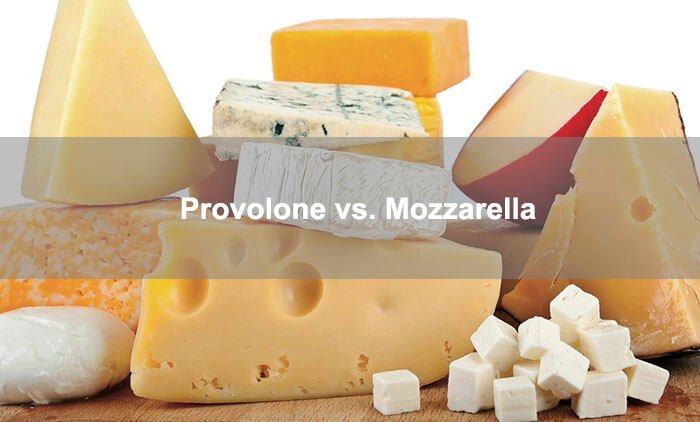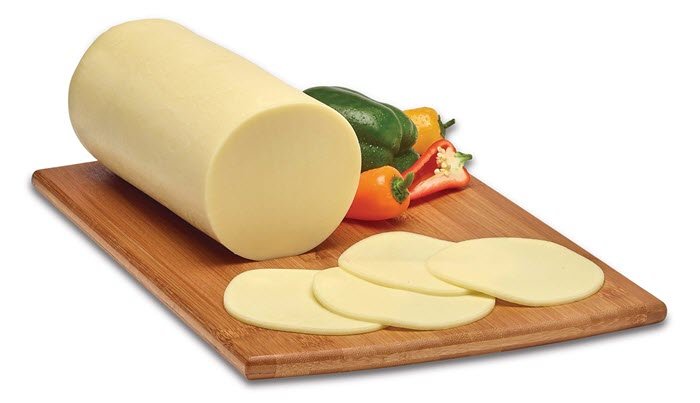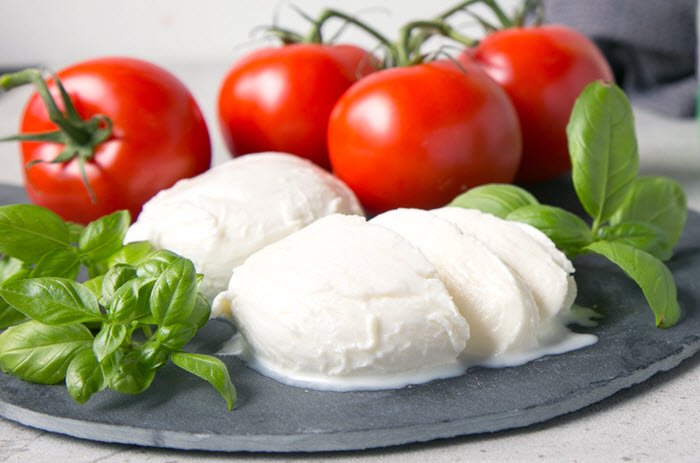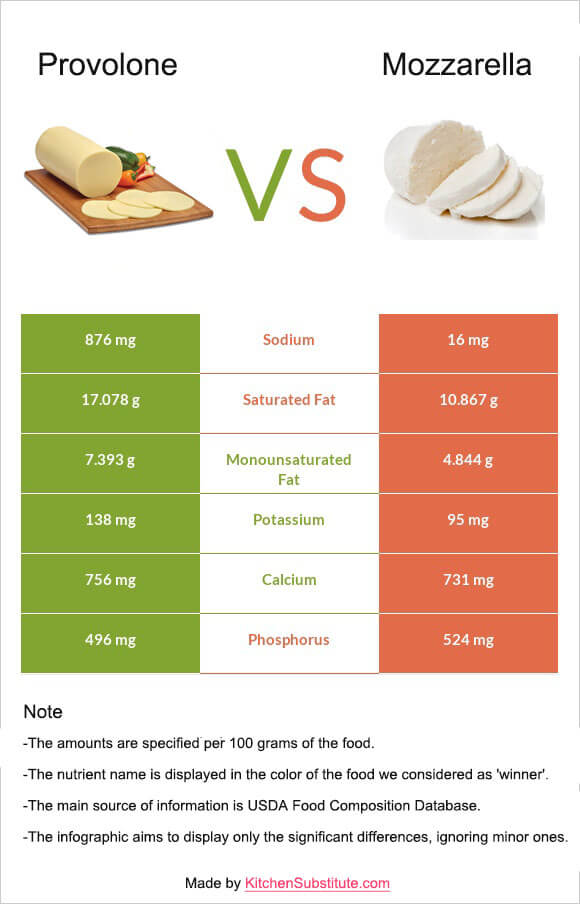Provolone and mozzarella cheeses look similar, but which one is better?
If you are a cheese-lover, it may be hard to decide. It might help to know what makes them different.
Read on to learn more about where the two kinds of cheese originate, their nutritional benefits, how they form, and their differences.
Next time you go to the supermarket, you’ll feel like a cheese expert and know exactly the difference between provolone and mozzarella, so you don’t mess up your favorite recipes.
Table Of Contents
Provolone vs. Mozzarella: What Are They?
Provolone and mozzarella are cheeses from Italy that resemble each other in color and nutrients but differ in many ways.
What is Provolone?
Provolone is an Italian cheese consisting of cow’s milk. It is a rigid cheese. There are two forms of provolone [1]:
- Provolone Dolce: This type of provolone is white to pale yellow and has a sweet taste. It ages over two to three months. Most American provolone is in this form.
- Provolone Piccante: The taste of this type is sharper. It takes more than four months to age.
Nutritional Benefits
Provolone cheese is nutritious. It is high in protein, which helps increase muscle mass and strength.
It contains calcium for stronger bones and teeth and phosphorus, which compliments the calcium.
Provolone also contains vitamins and minerals for red blood cell production, healthier skin, and better immunity.
A crucial mineral in provolone is zinc, which strengthens nails and protects the skin from the sun’s harmful UV rays.
Most cheese is high in fat and sodium, including provolone, which means consuming too much can increase your chances of health problems, such as high cholesterol or weight gain.
Bonus: we recently made a research on what can you substitute for provolone cheese, and found 15 best options. Click here for more details.
What is Mozzarella?
Mozzarella is a type of Italian white cheese. It traditionally originates from buffalo milk but can consist of cow’s milk instead.
It has a milder, sweeter taste than provolone. It is a softer cheese that melts well and works great in many dishes, especially pizza and salads.
It is the only cheese that you can make at home because it does not require curing. Other types of mozzarella cheeses are [2]:
- Mozzarella di Bufala (Buffalo mozzarella): Comes from the milk of tame water buffalo.
- Mozzarella Fior di Latte: Consists of pasteurized or unpasteurized cow’s milk.
- Low-moisture mozzarella: Derives from whole or part-skim milk.
- Mozzarella Affumicata: A smoked form of mozzarella.
Nutritional Benefits
Mozzarella has nutritional value as well. It also consists of protein and calcium, although the levels are lower than those in provolone cheese.
What’s more, it has less fat and sodium than provolone.
Mozzarella cheese contains bacteria [3] that help your body fight infection and improve your digestion. Like probiotics, those bacteria help promote your body’s good intestinal flora, allowing for a healthier gut.
Provolone vs. Mozzarella: What’s the Difference?
This picture is protected by copyright. You MUST link to us when using it!
Provolone and mozzarella taste great and blend well with other ingredients.
They both use Rennet to form curds and go through stretching known as Pasta Filata.
They also have similar processes of cheese making, but there are many differences between them. The most different is curation time and flavor.
Provolone
Making provolone takes a matter of months before it goes to the consumer.
The milk comes from local farms and goes to a factory, where its fat turns into cheese. It takes a temperature of 98-102 degrees F to get the milk hot enough for processing.
The curds separate from the rest of the milk, lose their water and milk solids and become dry before simmering in high heat for several hours.
Once the curds dry, the stretched cheese cures for about three months.
Because it is rigid, provolone does not melt well. It tastes strong and tangy. It is delicious on sandwiches. It has a longer shelf-life than mozzarella, meaning it can last up to two to three weeks.
Mozzarella
Mozzarella does not require curing before it is ready to eat. You can eat right away after production.
The process of manufacturing mozzarella is simple and similar to provolone but does not take as long.
Mozzarella is not dry like provolone. The curds separate from the whey in the milk heating and remain moist. The cheese has a soft texture by the end of the making process and is ready to eat immediately.
Mozzarella is more versatile than provolone and melts well. It has a buttery taste. Unlike provolone, mozzarella does not last long, so you need to eat it soon after buying.
FAQ About Provolone and Mozzarella
Here are some common questions about provolone and mozzarella cheeses.
Is provolone better than mozzarella?
It depends on what type of cheese you prefer.
If you want a soft, mild cheese, mozzarella is the way to go. If you like a harder cheese with some tang, you may like provolone better.
Which cheese is more nutritious?
Both kinds of cheese are full of nutrients, such as calcium, protein, vitamins, and minerals. If you are on a low-fat diet, mozzarella may be the better choice.
Mozzarella has lower fat content than provolone. It is also lower in sodium and calories overall.
Provolone has a higher protein and calcium content, making it wiser the option for a pre-workout snack.
Can I substitute one cheese for the other?
Yes, you can use provolone in place of mozzarella and vice versa.
Provolone and mozzarella are both stretchy types of cheese, but they have different consistencies.
Provolone is a harder cheese than mozzarella, so it may not melt as well.
Because mozzarella is milder, you may need to add more seasonings to your dishes. Provolone, on the other hand, provides enough savor.
In what dishes can I use provolone cheese?
Provolone cheese is good in a variety of meals. It will work on pizza, but it does not melt as well as mozzarella.
It tastes great in pasta, casseroles, and sandwiches. You can even mix it with vegetables.
In Summary
Now that you know the difference between provolone and mozzarella, you can decide which cheese to use in your next recipe.
Both kinds of cheese contain protein, calcium, and other nutrients, but mozzarella is healthier overall.
Mozzarella is a softer cheese with a mild buttery taste, whereas provolone is more rigid and tangy.
Provolone lasts longer and can stay in the fridge for up to three weeks. Mozzarella is a fresher cheese that you will spoil if you do not eat it soon after purchase.




